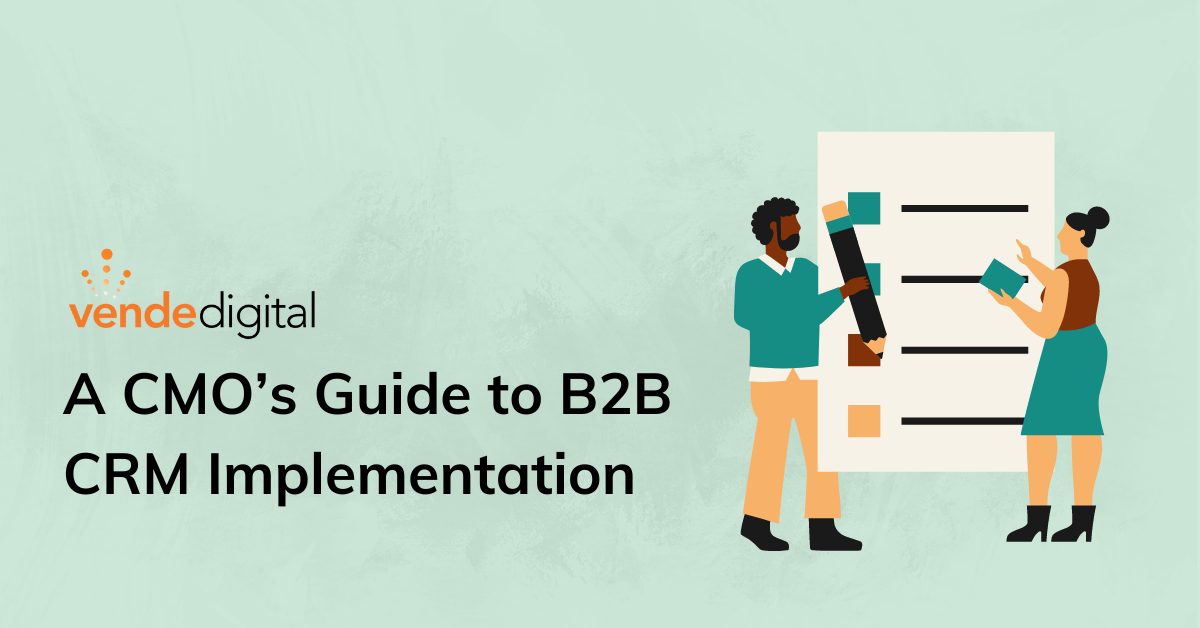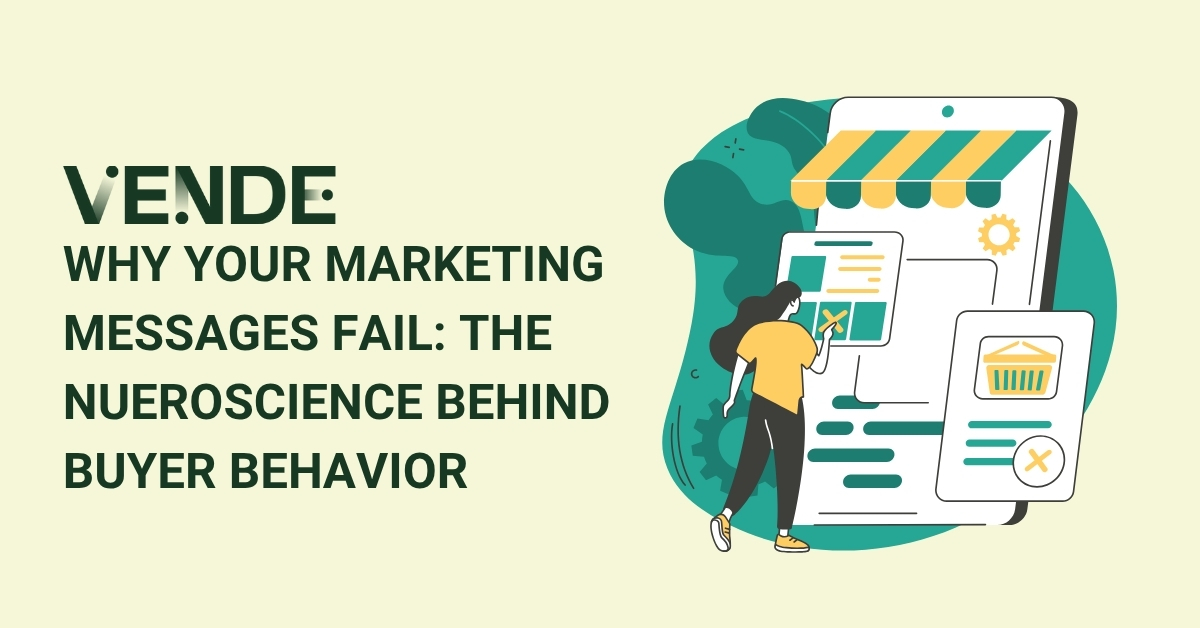
B2B CRM Implementation: A CMO's 20-Point Strategic Guide
Is your B2B company considering a new CRM system? Your strategic oversight as a CMO will be crucial for the success of this initiative.
This B2B CRM Implementation Guide is for you if:
- You’re a CMO in a B2B company considering a new CRM system
- You’re looking to maximize the ROI of your CRM implementation
- You want to align your CRM strategy with broader business goals
We’ve compiled a comprehensive 20-point checklist to guide you through the strategic considerations of CRM software implementation. Let’s dive in!
Want to dive deeper into CRM optimization? Watch our on-demand webinar that unpacks common CRM software mistakes and shares actionable strategies for transforming your CRM into a powerful CXM tool.
The Ultimate CMO’s Customer Relationship Management (CRM System Implementation Checklist
1. Define Clear Objectives
Remember the adage, “If you don’t know where you’re going, any road will get you there”? That’s especially true for implementing Customer Relationship Management (CRM). Your CRM isn’t just a tool—it’s a reflection of your business goals. Your CRM software strategy must be enterprise-centric to create value across your organization.
How to define clear CRM objectives
- Meet with key stakeholders from the sales team, marketing, and customer service
- Identify specific, measurable outcomes you expect from the CRM
- Align these objectives with your overall business strategy
- Define your Ideal Customer Profile (ICP) to ensure efforts are aimed at attracting and nurturing the right leads
- You’ll want to configure the CRM system to prioritize leads and opportunities that align with your ICP
Readiness Questions to Ask Your Team
- Have we clearly defined what success looks like for our CRM implementation?
- Are our CRM objectives directly tied to our business KPIs?
Red Flags:
- Vague objectives like “improve customer relationships”
- Misalignment between CRM goals and overall business strategy
Pro Tip: Create a Customer Relationship Management (CRM) mission statement. It sounds corny, but it works. This one-liner will guide all your decisions moving forward.
2. Secure Leadership Buy-In
You wouldn’t set sail without a captain, would you? The same goes for CRM software implementation.
How to secure leadership buy-in
- Develop a compelling business case highlighting CRM benefits
- Showcase potential ROI through data and case studies
- Engage leaders through workshops and regular progress updates
Readiness Questions To The C-Suite
- Do we have an executive sponsor championing our CRM software initiative?
- Are all C-suite members aware of how the CRM will impact their departments?
- Can we count on C-suite champions to set an example by using the CRM system?
Red Flags:
- Lack of interest or involvement from top leadership
- CRM is viewed as “just another IT project”
Pro Tip: Use storytelling. Share a “day in the life” scenario showing how the CRM will transform operations.
3. Adopt an MVP Approach
In the world of Customer Relationship Management (CRM), more isn’t always better. Start small, think big. This doesn’t mean settling for less. It does mean starting with a solid foundation and building from there.
How to develop an MVP approach:
- Identify core functionalities that directly contribute to primary business objectives.
- Prioritize features that will bring the most immediate value to your team
- Plan for phased implementation, starting with a pilot group
- Identify crucial data points essential for decision-making
- Determine which data fields are essential for team access
- Identify who will need access to specific data
Readiness Questions to Ask Your Team
- Have we identified our “must-have” vs. “nice-to-have” CRM features?
- What are the essential business processes your CRM must support?
- Which features directly contribute to our primary business objectives?
Red Flags:
- Trying to implement all features at once
- Lack of prioritization in feature rollout
Pro Tip: Create a “parking lot” for future features. It keeps excellent ideas alive without cluttering your MVP.
4. Create a Comprehensive Roadmap
A journey of a thousand miles begins with a single step – and a good map.
How to build a roadmap
- Identify how a customer interacts with your brand and how these interactions will be managed in your CRM system
- Break down the CRM implementation into phases with clear deadlines
- Visually map out CRM workflows
- Establish realistic timelines for each rollout phase
- Assign responsibilities to specific teams or individuals
- Include buffer time for unexpected challenges
- Anticipate challenges like data migration issues or user resistance.
- Have contingency plans ready
- Communicate regularly with stakeholders to inform them about progress and changes
Readiness Questions to Ask Your Team:
- Do we understand the steps a contact goes through from first touch to loyal customer?
- Do we know what actions indicate a lead is sales-ready?
- Do we have a clear timeline for each phase of implementation?
- Have we identified key milestones and checkpoints?
Red Flags:
- Not understanding the entire customer journey and how it will be managed in the CRM system
- Lack of clear timelines or milestones
- No contingency plans for potential delays
Pro Tip: Use a visual architecture roadmap. It’s easier for everyone to understand and rally behind. Click here to see Vende Digitals roadmap.
5. Prioritize Customer Data Standardization & Management
Your Customer Relationship Management (CRM) is only as good as the data it contains. Garbage in, garbage out. Standardized data entry is crucial for maintaining data quality over time.
How to ensure good data standardization management:
- Create clear guidelines and establish rules for how data should be entered
- Establish data entry protocols and train staff accordingly
- Plan for data drop-down menus and picklists over free-text fields
- Implement data validation rules to maintain quality
- Schedule regular data audits and cleaning sessions
Readiness Questions to Ask Your Team:
- Do we have clear data quality standards?
- Is there a process for ongoing data maintenance?
- Have we established rules for how data should be entered?
- Are there standardized formats for phone numbers, addresses, etc.?
Red Flags:
- There are lots of duplicate records and incomplete data in the current CRM
- No clear data governance policies
- Resistance to data cleaning efforts
Pro Tip: Appoint data stewards in each department to champion data quality.
6. Focus on User Adoption
A CRM system is like a gym membership—it only works if you use it. Be patient and persistent, and always focus on the ‘why’ behind CRM use.
How to ensure user adoption:
- Pick a user-friendly CRM system to match your team’s workflow
- Involve end-users in the selection and customization process
- Develop role-specific training programs
- Show your team how the CRM makes their job easier
- Get leaders involved in using the CRM system
- Use CRM reports in team meetings for decision-making
- Showcase early wins to build momentum
Readiness Questions to Ask Your Team:
- Have we identified potential adoption challenges?
- Is there a plan to measure and improve user adoption rates?
Red Flags:
- Low engagement in CRM training sessions
- High variability in CRM usage across teams
Pro Tip: Create a “CRM Champions” program to recognize and reward power users.
Need more help? Check out our guide on overcoming CRM challenges to boost your marketing success. This guide will help you:
- Tackle Common CRM Hurdles: Learn solutions for data quality issues, low user adoption, and complex workflows.
- Optimize Your CRM Strategy: Discover actionable tips for integrating tools, measuring ROI, and scaling your CRM as your business grows.
- Drive Actionable Insights: Leverage advanced analytics and AI capabilities to unlock the full potential of your CRM data.
7. Integrate with Existing Systems
Your CRM shouldn’t be an island. It needs to play nice with others.
How to plan for integration
- Map out all systems that need to integrate with the CRM
- Prioritize integrations based on business impact
- Test integrations thoroughly before full rollout
Readiness Questions to Ask Your Team
- Have we identified all necessary system integrations?
- Is there a plan for data flow between systems?
Red Flags:
- Siloed data across different systems
- Lack of API documentation for critical systems
Pro Tip: Start with your most critical integration. Get it right, and you’ll build confidence for the rest.
8. Train Your Team
Knowledge is power, especially when it comes to CRM. Your CRM system is only as good as the people using it.
How to ensure your team is set up for success
- Develop role-specific training materials
- Communicate the personal benefits of effective CRM use
- Offer a mix of hands-on practice and theoretical learning
- Provide ongoing training for updates and new features
Readiness Questions to Ask Your Team:
- Do we have a comprehensive training plan for all user levels?
- Is there a system for addressing user questions and concerns?
- Does our team understand how CRM usage ties to business goals?
Red Flags:
- One-size-fits-all training approach
- No plan for ongoing education
Pro Tip: Have a dedicated person or team for CRM-related questions and create an internal knowledge base or wiki for CRM best practices and FAQs.
9. Establish Clear KPIs and Metrics
If you can’t measure it, you can’t improve it. Your CRM metrics should tell a story about your business health and guide daily decisions.
How to set up metrics that drive CRM success:
- Define KPIs that align with your CRM objectives
- Set up dashboards for easy monitoring of these metrics
- Make sure each team can easily access their performance metrics
- Schedule regular review sessions to assess progress
- Automate alerts for fundamental metric changes
Readiness Questions to Ask Your Team
- Do our CRM metrics directly support our business goals?
- Is there a straightforward process for acting on these metrics?
Red Flags:
- Too many metrics lead to analysis paralysis
- Metrics that don’t drive actionable insights
Pro Tip: Include leading indicators in your KPIs. They’ll help you spot trends before they become problems.
10. Embrace Automation and AI
Let the robots do the heavy lifting. Strategic automation can dramatically increase your CRM’s efficiency. Start by identifying repetitive tasks, setting up workflows, and integrating with other tools.
How to Leverage Automation and AI in Your CRM:
- Understand your CRM’s built-in automation features
- Identify repetitive tasks your team does multiple times a day or week
- Look for manual processes that eat up time
- Identify tasks that are prone to human error
- Set up automated workflows to handle these
- Find integrations that reduce the need for manual data entry
- Implement AI-driven insights and recommendations
- Continuously refine automation rules based on results
Readiness Questions to Ask Your Team:
- Have we identified processes that could benefit from automation?
- Is our team prepared to work alongside AI-driven insights?
- Have we explored AI Agent features?
Red Flags:
- Over-automation leads to loss of personal touch
- Resistance to AI-driven recommendations
- Lack of understanding of AI-enabled features in your CRM platform
Pro Tip: Start with email automation. It’s an easy win that can dramatically improve efficiency.
11. Develop a Change Management Strategy
Change is hard. Make it easier with a solid plan.
How to manage change
- Communicate the benefits of the CRM clearly and consistently
- Address concerns and resistance proactively
- Celebrate small wins to build momentum
- Involve users and managers from the beginning
- Get their input and feedback throughout the process
- Recognize and reward desired behaviors to reinforce adoption
Readiness Questions to Ask Your Team:
- Have we identified potential sources of resistance?
- Is there a communication plan for each stage of implementation?
Red Flags:
- Lack of leadership buy-in
- Lack of clear messaging about CRM benefits for affected departments
- Ignoring or dismissing user concerns
Pro Tip: Use a mix of communication channels. Some people prefer emails, while others respond better to in-person meetings.
12. Prioritize Mobile Accessibility
In a mobile-first world, your CRM needs to keep up.
How to ensure your CRM has robust mobile functionality
- Offline Access – access and update CRM data without an internet connection, with automatic synchronization once back online
- Contact Management – access to customer profiles, contact information, and interaction history
- Task Management – ability to create, assign, and track tasks while on the go.
- Real-time Data Updates – synchronization of data across all devices
- Email and Calendar Integration – Integration with mobile email and calendars
- Document Access and Management – the ability to access, share, and manage important documents and files
- Mobile Notifications – real-time alerts and notifications for important tasks.
- Data Security – security features to protect sensitive customer data on mobile devices
Readiness Questions to Ask Your Team:
- Does our CRM offer a fully-featured mobile app?
- Does our CRM provide an intuitive, easy-to-use mobile interface optimized for smaller screens?
- Have we tested mobile functionality in real-world scenarios?
- Do we provide training specific to mobile CRM use?
Red Flags:
- Limited functionality in the mobile version
- Poor user experience on mobile devices
Pro Tip: Make mobile adoption a competition. Gamification can drive engagement.
13. Ensure Scalability and Flexibility
Your CRM should grow with you, not hold you back.
How to pick a CRM platform that scales
- Understand how adding seats, features, or growing contacts will impact price over time.
- Choose a CRM with a track record of regular updates
- Ensure the CRM can handle your projected data volume
- Look for customization options to fit your unique needs
Readiness Questions to Ask Your Team:
- Can this CRM support our growth plans for the next 3-5 years?
- Does it offer the flexibility to adapt to changing business needs?
Red Flags:
- CRM software pricing becomes cost-prohibitive as you grow
- CRM struggles with the current data volume
- Limited options
Pro Tip: Don’t just consider user numbers. Consider data volume, integration complexity, and reporting needs, too.
14. Implement Strong Security Measures
In the age of data breaches, security isn’t optional.
How to implement strong security measures
- Implement role-based access controls
- Ensure data encryption both in transit and at rest
- Regularly audit and update security protocols
Readiness Questions to Ask Your Team
- Does our CRM meet all relevant data protection regulations?
- Do we have a plan for regular security audits?
Red Flags:
- Lack of multi-factor authentication
- No clear process for handling data breaches
Pro Tip: Make security part of your onboarding process. Every new user should understand their role in keeping data safe.
15. Focus on Customer Experience Management (CXM)
CRM is evolving. Are you keeping up? Future-ready CXM is more than just a database – it’s the central nervous system of your entire customer experience strategy.
How to move from CRM to CXM
- Map the entire buyer’s journey within your CRM
- Identify how these departments interact and depend on each other
- Understand where data flows and how it’s shared
- Use CRM data to personalize customer interactions
- Implement feedback loops to continuously improve CX
Readiness Questions to Ask Your Team
- Can our CRM provide a 360-degree view of the customer?
- Are we using CRM data to enhance customer experiences?
Red Flags:
- Siloed customer data across different touchpoints
- Lack of personalization in customer interactions
Pro Tip: Create customer journey maps in your CRM. This will help everyone understand how their role impacts the customer experience.
16. Leverage Analytics for Decision Making
Your CRM is a goldmine of insights. Start digging.
How to leverage CRM analytics
- Ensure data quality and integration across systems
- Plug data leaks and implement good data hygiene
- Foster a data-driven culture across the organization
- Implement advanced analytics and reporting features
- Train teams on how to interpret and act on CRM data
- Use predictive analytics to forecast trends and behaviors
- Provide proper training to teams on using analytics tools and insights
- Continuously test and refine your analytical models and approaches
Readiness Questions to Ask Your Team
- Are our teams equipped to make data-driven decisions?
- Can we easily generate the reports we need for strategic planning?
Red Flags:
- Underutilization of CRM reporting features
- Decisions being made without consulting CRM data
Pro Tip: Create a “data insights” newsletter or Slack channel. Share key findings from your CRM analytics regularly.
17. Implement Continuous Improvement Processes
Your CRM journey doesn’t end at implementation. It’s just the beginning. Regular reviews ensure it remains a valuable asset, not an outdated liability.
How to continuously improve your CRM system
- Schedule regular CRM health checks
- Regularly clean and update your data
- Customize and streamline workflows
- Gather and act on user feedback consistently
- Stay updated on new CRM features and industry trends
Readiness Questions to Ask Your Team:
- Do we have a process for ongoing CRM optimization?
- Is there a system for collecting and implementing user suggestions?
- Are you reviewing data quality and completeness quarterly?
- Do we assess user adoption rates and pain points regularly?
Red Flags:
- “Set it and forget it” mentality post-implementation
- Ignoring user feedback or feature requests
Pro Tip: Form a cross-functional CRM optimization team. Meet quarterly to review and improve your CRM strategy.
18. Align CRM Strategy with Customer Journey and Sales Pipeline
Your CRM should mirror your customer’s journey, not your org chart.
How to align your CRM system with your customer’s journey
- Map your customer journey stages to CRM processes
- Customize CRM fields and processes to match journey stages
- Ensure data collection aligns with each journey stage
- Set up automation for each journey stage
- Create customer journey-focused reports and dashboards
Readiness Questions to Ask Your Team:
- Does our CRM support each stage of the customer journey?
- Can we easily track a customer’s progress through their journey?
Red Flags:
- CRM processes that don’t align with real customer behaviors
- Inability to view a customer’s full journey history
Pro Tip: Use your CRM to create a “customer health score” based on journey milestones.
19. Develop a Vendor Management Strategy
Your CRM vendor should be a partner, not just a provider.
How to turn your CRM provider into a partner
- Consider working with a top-tier agency to help manage vendor relationships
- Establish clear communication channels with your vendor
- Set expectations for support, updates, and issue resolution
- Regularly review vendor performance against SLAs
- Designate a dedicated point of contact
Readiness Questions to Ask Your Team:
- Do we have a dedicated point of contact with our CRM vendor?
- Do we have in-house expertise in CRM management?
- Is there a clear escalation process for critical issues?
Red Flags:
- Poor responsiveness from vendor support
- Lack of clarity on product roadmap or future developments
Pro Tip: Join your CRM’s user community and plan on attending their annual conferences. It’s a great way to influence product development.
20. Create Executive-Level Dashboards
Help your C-suite see the forest for the trees.
How to build dashboards your C-Suite will love:
- Identify key metrics that matter to executives
- Create visually appealing, easy-to-understand dashboards
- Get executive input and feedback during the design process
- Make them actionable by showing trends, comparisons, and progress towards goals
- Ensure real-time or near-real-time data updates
Readiness Questions to Ask Your Team
- Have we identified the CRM insights most valuable to our executives?
- Can our C-suite easily access these insights without IT support?
Red Flags:
- Executives not engaging with CRM data
- Dashboards that are too complex or not actionable
Pro Tip: Schedule monthly “CRM insight” sessions with your executive team. Use this time to translate CRM data into strategic actions.
Unlock B2B Growth with Our Expert CRM Comparison Guide
This comprehensive guide will help you supercharge your B2B marketing and sales efforts with the perfect CRM solution.
- Choose the Right CRM: Compare top platforms like HubSpot, SharpSpring, and ActiveCampaign across 55 key features.
- Align Marketing and Sales Team: Learn which CRM features are crucial for seamless team collaboration and enhanced productivity.
- Maximize ROI: Understand how CRM can transform your pipeline and drive reliable results.
Your CRM Journey Starts Now
Implementing a CRM system is more than a technical challenge – it’s a strategic opportunity. As a CMO, your leadership in this process can transform how your organization understands and serves its customers.
Remember, a successful CRM implementation is more than having the most features. It’s about having the right features that drive your business forward. Ready to take your CRM strategy to the next level? Don’t let another day go by with an underperforming CRM. Contact Vende Digital today for a free consultation and discover how we can help you achieve CRM success. Your optimized CRM journey starts here – let’s make it happen!








